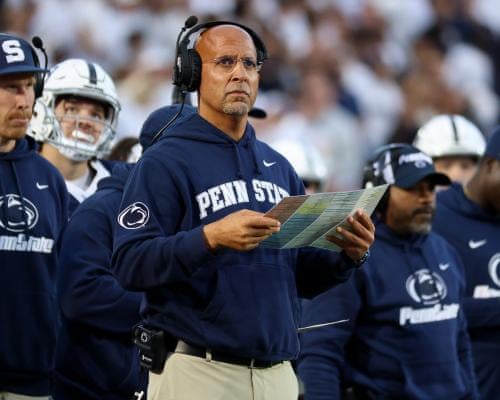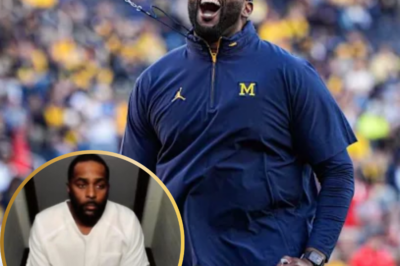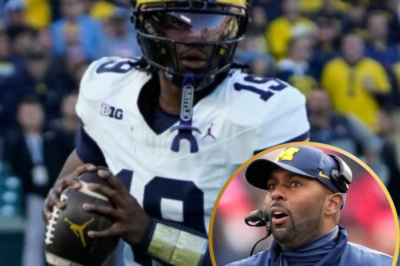We have the leaked document. Penn State’s private message to players after canning James Franklin has been exposed, and it’s even messier than you think
In the high-stakes, multibillion-dollar ecosystem of modern college athletics, few moments are as intensely private and critically managed as the dismissal of a head coach.
It is a period of profound vulnerability for an institution, a crucible where the delicate balance between cold corporate decision-making and the raw humanity of a team of young athletes is tested.
The protocol for such an event is meticulously scripted: private meetings, controlled messaging, and a unified front, all designed to project stability in the eye of a hurricane of change.
But what happens when that script is ripped up and thrust into the public domain?
This is the unprecedented crisis that has engulfed Happy Valley, as a confidential internal letter, penned by the Penn State University administration and intended solely for the eyes of the Nittany Lions football players in the immediate aftermath of Head Coach James Franklin’s firing, was leaked to the public.
This is not merely a story about a coach being fired; that, in itself, is a common enough narrative in the volatile world of college football.
This is a story about a profound institutional breach, a shattering of trust, and a rare, unvarnished glimpse into the internal machinations of a football powerhouse in its most fragile moment.
The contents of the letter, the nature of its dissemination, and the subsequent fallout have sent shockwaves through the world of collegiate sports, raising urgent questions about privacy, leadership, player empowerment, and the very soul of a program defined by its tradition and its tumult.
The Calm Before the Storm – The James Franklin Era in Review

To fully comprehend the seismic impact of the leak, one must first understand the context of the James Franklin era at Penn State.
Hired in 2014, Franklin arrived from Vanderbilt tasked with the Herculean mission of steering the Nittany Lions out of the dark, punitive shadows of the Sandusky scandal sanctions.
He was a dynamo of energy, a master recruiter famously branded as a “great developer of men,” and a charismatic leader who promised to not only build a winning team but to restore the “Grand Experiment” of success with honor.
His tenure was a rollercoaster of soaring highs and perplexing lows. He delivered a memorable Big Ten Championship in 2016, a feat that cemented his status as a savior for many in the Nittany Lion faithful.
He consistently pulled in top-tier recruiting classes, bringing elite talent to State College. However, the perennial critique, the nagging thread that unraveled his long-term security, was an inability to breakthrough on the national stage.
Season after season, Penn State found itself on the cusp of the College Football Playoff, only to stumble in one or two critical games, often against arch-rivals Ohio State and Michigan.
The narrative of “so close, yet so far” became a heavy mantle. The 2023 season, with its preseason hype and subsequent disappointing finish, appeared to be the final straw for an administration facing immense pressure from a divided booster base and a restless fanbase whose expectations had recalibrated to national title contention.
The decision to fire Franklin, while debated hotly on talk radio and in online forums, was ultimately a football decision. But the aftermath of that decision, as we now know, was where the true drama was just beginning.
The Day the World Heard: How the Letter Was Leaked and the Immediate Firestorm
The official announcement of James Franklin’s dismissal was made on a Sunday evening, a standard public relations tactic to dominate the Monday news cycle.
The university released a polished, formal statement from the Athletic Director, thanking Franklin for his service and emphasizing a “new direction” for the program.
Simultaneously, as is standard practice, a separate, more personal communication was dispatched directly to the players of the football team.
This internal letter, authored by a high-ranking university official (sources suggest it was a joint effort from the Athletic Director and the President’s office), was the institution’s attempt to speak to its own—to console, to explain, and to command loyalty during a period of profound uncertainty.
The existence of this letter was not public knowledge. Its contents were meant to be a private covenant between the university and its student-athletes.
Yet, within mere hours of its distribution, the document began appearing on social media platforms, initially in blurred screenshots on fan forums, before being published in full by aggressive sports news outlets.
The speed and brazenness of the leak pointed to an internal source.
The digital trail suggested the document was leaked by someone with direct access to the team’s private communication channels—a player, a staff member, or someone within the athletic department’s inner circle.
The motive remains a subject of intense speculation: Was it an act of protest by a disgruntled player loyal to Franklin?
A calculated power play by a faction within the administration? Or simply a reckless, impulsive share that spiraled catastrophically out of control? Regardless of the intent, the effect was instantaneous and explosive.
The sports media world, which had been covering the firing as a major story, now had a nuclear core of new content.
News alerts blared. Social media timelines were flooded with excerpts. Talk shows scrapped their planned segments.

The narrative instantly pivoted from “Why was Franklin fired?” to “What did Penn State really tell its players, and why is it now public?”
A Line-by-Line Analysis: Deconstructing the Shocking Content of the Leaked Letter
The leaked letter itself is a fascinating document, a study in corporate-speak, crisis management, and, in some passages, startling candor.
A thorough analysis reveals several key themes that have become the focal point of the controversy.
The Framing of Franklin’s Dismissal: “Philosophical Misalignment” or Something More?
The letter went beyond the standard “we thank him for his service” boilerplate. While it acknowledged Franklin’s contributions, it articulated the reason for his dismissal as a “fundamental philosophical misalignment with the future trajectory of Penn State Football.”
This vague corporate jargon has been widely parsed. Did it refer to on-field strategy, such as offensive scheme or game management?
Did it point to off-field issues, like NIL (Name, Image, and Likeness) management or recruiting tactics? Or was it a euphemism for the simple, unsentimental reality that he wasn’t winning enough big games?
The ambiguity has fueled endless debate, with critics arguing the administration failed to provide the players with a concrete, respectful explanation for a decision that upended their lives.
The Direct Appeal to the Locker Room: A Plea for Retention.
Perhaps the most scrutinized section of the letter was its direct, almost pleading appeal to the current players to not enter the NCAA Transfer Portal. In an era where player mobility is at an all-time high, a coaching change often triggers a mass exodus of talent, potentially setting a program back years.
The letter explicitly stated, “We urge you to pause, to reflect, and to trust the process we have in place to find a leader who shares our core values and your competitive fire.” It promised a “nationwide search for a visionary coach” and emphasized the university’s commitment to providing “unparalleled support” during the transition.
This section has been interpreted by many analysts as the letter’s primary objective: damage control on roster retention.
However, to players and observers sympathetic to the athletes, it came across as a self-serving plea from an institution that had just created the instability it was now asking the players to endure.
The “Core Values” Incantation and the Shadow of History.
Given Penn State’s unique and painful history, the repeated invocation of “core values,” “the Penn State Way,” and “the lessons of our past” carried immense weight. The letter leaned heavily on this institutional identity, attempting to frame the coaching change not just as a tactical shift, but as a moral and cultural recommitment.
For some, this was a powerful and necessary reminder of what makes Penn State distinct. For others, it rang hollow, seen as using the university’s most painful chapter as a rhetorical shield to justify a controversial football decision.
The Omissions and What Was Left Unsaid.
Equally telling were the letter’s omissions. There was little concrete detail about the search process for a new coach, no specific timeline, and no mention of interim leadership.
There was no acknowledgment of the personal relationships between the players and the now-dismissed coaching staff, a emotional void that many players likely felt deeply. The letter existed in a sterile, forward-looking vacuum, seemingly ignoring the very human disruption it was announcing.
The Domino Effect: Immediate Consequences and Reactions
The leak did not exist in a vacuum; it triggered an immediate and cascading series of reactions from every corner of the Penn State universe and beyond.
The Player Reaction: Within the locker room, the leak created an atmosphere of paranoia and betrayal. Who among them had leaked it?
Trust, the bedrock of any team, was instantly fractured. Publicly, players expressed their reactions through social media—some with cryptic posts, others with clear messages of support for the departed Franklin, and a few with “likes” or shares of articles critical of the administration. The most significant tangible reaction was the movement in the transfer portal.
While a few entries were expected, the leak arguably accelerated decisions and created a sense of freefall, as players questioned the stability and confidentiality of the very institution asking for their patience.
The Coaching Carousel: For potential coaching candidates, the leak was a double-edged sword. On one hand, it was a high-profile job opening.
On the other, it revealed an administration potentially grappling with internal leaks and a fractured relationship with its team. Top-tier candidates would now have to weigh the appeal of the Penn State brand against the apparent dysfunction laid bare by the leaked document.

The Media Frenzy: The leak was a gift to the 24/7 sports news machine. It provided a deep, text-based source for endless analysis, speculation, and debate. Pundits took sides, with some lambasting the administration for the leak’s content and its incompetence in allowing it to happen, while others defended the tough decisions of leadership. The story evolved from a one-day firing announcement into a multi-week saga.
The Fanbase Divide: The Nittany Lion fanbase, never a monolith, was thrown into deeper turmoil. Franklin loyalists used the letter’s contents to argue the administration had acted rashly and disrespectfully. Those who wanted a change rallied around the “philosophical misalignment” language as validation of their position. The leak ensured that the conversation would not be about unity moving forward, but about re-litigating the dismissal and assigning blame for the ensuing chaos.
The Broader Implications: A Cautionary Tale for College Athletics
The Penn State leak transcends the borders of Happy Valley. It serves as a stark cautionary tale for every major collegiate athletic program in the country, highlighting several critical issues in the modern era.
The Erosion of Institutional Control: In the age of smartphones and instant communication, the concept of a truly private, internal message is almost antiquated. This incident demonstrates the near-impossibility of controlling a narrative once a digital document is in the wild. University presidents and athletic directors nationwide are likely revisiting their crisis communication plans, realizing that any internal memo must be written with the assumption that it could become public.
Player Empowerment in the NIL and Transfer Portal Era: The leak is a powerful symbol of the shifted power dynamic in college sports. Players are no longer passive recipients of decisions made by faceless administrators. They have agency—through the portal and their social media platforms—and they are willing to use it. The letter’s plea for players to stay was a tacit acknowledgment of this power. The act of leaking it can be seen as an exercise of that same power, a way for an anonymous individual within the program to shape the external narrative and hold the administration accountable in the court of public opinion.
The Journalistic Dilemma: The leak also poses an ethical question for sports journalism. Outlets that published the letter in full were operating in a grey area. They were disseminating newsworthy information that was clearly in the public interest, but they were also publishing a document that was never intended for public consumption and whose release constituted a breach of trust. This tension between the public’s right to know and the right to privacy of an institution and its athletes is a defining challenge of modern sports media.
The Path Forward: An Uphill Battle for Penn State
For Penn State, the path to recovery is now significantly steeper. The search for a new head coach is no longer just about finding a brilliant football mind; it is about finding a leader who can walk into a fractured locker room, heal the wounds of betrayal, and unite a splintered fanbase. This individual must be a master communicator, a culture-builder, and someone with the credibility to restore faith both inside and outside the program.
The administration itself must conduct a thorough internal investigation to identify the source of the leak, not for the purpose of public retribution, but to understand the breakdown in its own processes and to rebuild internal trust. They must engage in transparent, honest communication with the current players, addressing their concerns head-on without the corporate filter that characterized the leaked letter.
The 2024 season, regardless of who is hired, will now be played under the microscope of this scandal. Every loss, every player departure, will be analyzed through the lens of the “leak fallout.” The narrative has been set.
News
VIDEO: Viral Prison Livestream Shows Coach Sherrone Moore’s Raw, Unfiltered Reaction To MAJOR News. You Won’t Believe What Happened.
VIDEO: Viral Prison Livestream Shows Coach Sherrone Moore’s Raw, Unfiltered Reaction To MAJOR News. You Won’t Believe What Happened. In…
VIDEO: What Falcons’ Zane Gonzalez did moments before his game-winner reveals a hidden mental health battle.
VIDEO: What Falcons’ Zane Gonzalez did moments before his game-winner reveals a hidden mental health battle. In a stunning display…
Breaking News: New Report Reveals TJ Watt Hospitalization Linked to Medical Staff’s Critical Error by Pittsburgh Steelers
Breaking News: New Report Reveals TJ Watt Hospitalization Linked to Medical Staff’s Critical Error by Pittsburgh Steelers In a startling…
SHOCKING TNT MOMENT: Bijan Robinson’s live TV slip-up leaves everyone speechless — and a forced apology followed seconds later. You have to hear what he said.
SHOCKING TNT MOMENT: Bijan Robinson’s live TV slip-up leaves everyone speechless — and a forced apology followed seconds later. You…
EXCLUSIVE: Bryce Underwood Drops BOMBSHELL Post After Moore Firing! Michigan’s star QB just sent shockwaves through Ann Arbor with ONE social media move. Fans are LOSING IT.
EXCLUSIVE: Bryce Underwood Drops BOMBSHELL Post After Moore Firing! Michigan’s star QB just sent shockwaves through Ann Arbor with ONE…
SHOCKING SIGHT at The Big House: The adult film star who EXPOSED Sherrone Moore’s DMs was just spotted CHEERING IN THE STADIUM at a Michigan game. You won’t believe the video.
SHOCKING SIGHT at The Big House: The adult film star who EXPOSED Sherrone Moore’s DMs was just spotted CHEERING IN THE STADIUM at…
End of content
No more pages to load












